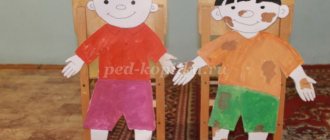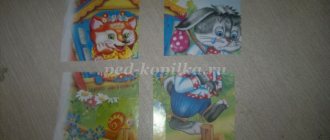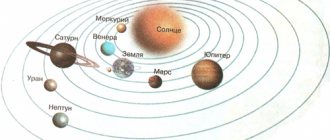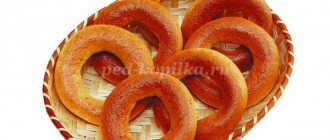Summary of a lesson on familiarization with nature in the junior group “Why are plants needed?”
Summary of a lesson on familiarization with nature in the junior group “Why are plants needed?”
Summary of a lesson on familiarization with nature in the junior group “Why are plants needed?”
Lesson in the younger group on learning about nature
Topic: “Why do we need plants?”
Target:
development of ideas about the relationship of plants with the outside world.
Tasks:
help expand children's knowledge about the importance of trees for animals and people, and develop an understanding of the need to protect the forest.
Progress of the lesson:
(the teacher tells and shows a fairy tale using the necessary visual attributes: the characters Masha and the Bear, several illustrations of spruce trees (forest, woodpecker, mouse, squirrel, crossbill)
- Guys, today I will tell you one very unusual story about Masha, who went skiing into the forest. And since she skated very poorly, from the very first hill she crashed into a tree and got a big bump.
- Why are there so many trees in the forest? – she grumbled, rubbing her forehead.
- Why is this? - she heard a voice - There must be a lot of trees in the forest. – Masha looked around and saw a Bear under the fir tree.
— Masha, trees provide many animals with shelter from predators and the wind. It's warmer here than in an open field. Christmas tree my friend. Besides me, many other animals are friends with the Christmas tree.
- Who else? – asked Masha.
- Look, a squirrel is running along the trunk of that tree. She builds her nest on a Christmas tree, although she can live in a hollow. She also has a lump in her paws
“I know,” said Masha. - She takes out the nuts and eats them.
“That’s right,” answered the Bear.
Then a woodpecker sat on a branch of a broken tree.
“And the woodpecker is friends with the Christmas tree!” said the Bear. “He takes out bugs and spiders from the bark of the tree, and can also feast on cones.”
“The Christmas tree gives the woodpecker food, and he helps her get rid of pests!” said Masha. - They help each other.
- Masha, there are still many animals and birds that are friends with the Christmas tree.
- Yes, now I understand it. The Christmas tree is very necessary for the forest, just like other trees and plants! - said Masha, heading home. – And I’ll definitely learn to ski. – She said goodbye.
Educator: Guys, who else do you think the spruce tree is friends with?
(Children's answers).
Man also needs spruce. From it and other trees growing in the forest, you can build a house, cut firewood for heating, and make boards. What else can you make from boards? Look around, what is made of wood here in the group? (Children's answers)
Cardboard and paper are made from trees. The forest takes a very long time to grow. Therefore, you need to take care of books and handle paper carefully. This will help save the forest.
Educator: In addition, the forest purifies the air and provides the oxygen we breathe. Without a forest, animals and birds cannot live, and people cannot live either. The forest is our wealth! It must be preserved and protected.
— Guys, what does it mean to protect the forest and nature? (Children's answers). That's right, it's not doing anything that could harm him.
- Let's look at the illustrations and tell you what not to do. (a ready-made set of pictures on the topic “What you should not do in the forest: do not break branches, do not trample poisonous mushrooms, do not pick flowers, do not make noise, do not touch or look at nests with bird eggs, do not litter, do not destroy anthills and do not catch wild animals").
- Well done guys, now I know for sure that when you go into the forest into nature, you won’t do anything bad.
- Guys, but we don’t go to the forest every day. How can we live in a city without plants and trees? (children's answers).
— In order to breathe clean air and create beauty around them, people improve their homes and streets. They plant trees and shrubs in their yards and streets. And in the spring, they plant a huge number of colorful flowers, which not only make us happy, but also purify our air, just like the trees.
- Today we will also try to make sure that our air is cleaned. And we were in a great mood all summer. Today we will plant flower seeds on your windowsill, which we will take care of all spring. And when the sun warms up the ground well outside, you and I will plant them in a flowerbed on our site!
(On the table is a box of seedlings, marigold seeds, and soil for planting. Children and the teacher plant plants).
— Today we learned how important trees and other plants are for us! Let's remember. (Children's answers)
- What did you like most of what we did today (Children’s answers)
Educational field: Child and nature
Form ideas: – about the characteristics of plants as living beings: they move, turn leaves, stems, flowers towards the sun, open and close petals, etc.; feed (the root absorbs water from the ground, the stem conducts water and food to other parts of the plant, the leaves catch light and nourish the plant); breathe leaves, stem (trunk), roots; “feel” the arrival of heat, cold, sunny or cloudy weather, etc.; grow and multiply; – methods of caring for plants in accordance with their needs: watering, loosening, removing dust from the leaf plate, weeding, sowing, planting, spraying, propagating plants (leaf and stem cuttings, mustaches); – the need to comply with the rules of behavior in the process of interaction with indoor plants and plants in the natural environment. Develop skills: – recognize and name 5–7 types of indoor plants (Tradescantia, amaryllis, Decembrist, ivy, indoor grapes, etc.), trees and shrubs (poplar, ash, jasmine, hazel, apple, pear, cherry, etc.), flowering plants (peony, dahlia, chrysanthemum, primrose, etc.), vegetables (carrots, tomatoes, potatoes, lettuce, dill, parsley, onions, garlic, etc.), weeds (quinoa, wheat grass, chickweed, etc.) , grain crops (rye, wheat, etc.), forest berries (lingonberries, blueberries, cranberries, etc.), mushrooms (boletus, aspen, russula, honey mushrooms, boletus, etc.), plants listed in the Red Book of the Republic of Belarus ( white water lily, yellow water lily, dream grass, lungwort, etc.); plants of hot countries and their fruits (palm, pineapple, orange, pomegranate, kiwi, peach, apricot, banana, etc.); – determine in the process of observation, experimentation and labor the functions of plant organs: roots absorb water and nutrients from the soil, hold the plant in the soil, breathe; stems transmit water, nutrients, hold branches, leaves, flowers, fruits; leaves absorb light, breathe, evaporate moisture; flowers breathe, bloom, form seeds; seeds contribute to the emergence of a new plant; – group plants according to different characteristics: life form (grass, bush, tree), leaf structure (deciduous, coniferous), relationship to humans (cultivated, wild), method of use (food, medicinal, ornamental), place of growth (forest, meadow plants, pond plants, garden plants, field plants, vegetable garden plants, flower garden plants); – characterize seasonal changes in the plant world: in the fall, leaves gradually color and fall, grass withers, crops ripen, people harvest in fields, vegetable gardens, orchards; in winter, trees and bushes without leaves do not grow because the necessary conditions are not available (no heat, water, loose soil, not enough light); in the spring the necessary conditions for plant growth appear, the buds swell, leaves and grass appear, flowers bloom first in sunny meadows, then in shaded places, in the summer the plants grow, bloom, bear fruit, as they have the necessary conditions; – correlate the state of plants with seasonal changes in inanimate nature. To educate: responsibility for the condition of plants in the immediate environment; desire to actively participate in nature conservation.




